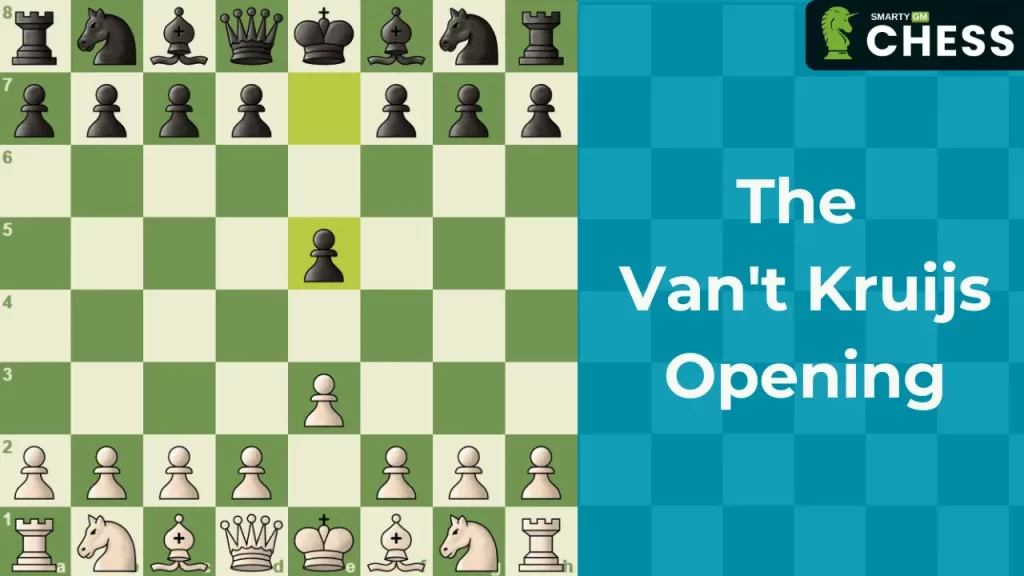Van’t Kruijs is an opening that is rarely used by chess players and begins with the move 1.e3. It diverges from mainstream lines, offering diverse pawn structures and creative opportunities.
In this article, we delve into the intricacies of The Van’t Kruijs Opening, exploring its history, key concepts, variations, and enduring impact on modern chess strategy.
Read also: How to Play The Danish Gambit Opening
What is Van’t Kruijs Opening?
The Van’t Kruijs (or the mouse slip) is a tactical chess opening that begins with 1.e3, named after the Dutch player Maarten Van’t Kruijs.
Although not as popular or widely studied as some of the more mainstream openings like the Sicilian Defense or the Ruy Lopez, the Van’t Kruijs Opening offers a presenting players with unique opportunities and challenges right from the outset.
How you can set up The Van’t Kruijs?
To set up the Van’t Kruijs Opening, you begin by playing 1.e3 as White.
Next, you’ll fianchetto your king’s bishop with 2.b3, (if Black plays e5) solidifying your position while retaining flexibility.
This move prepares to develop your bishop to b2 to put pressure on the center and controlling key diagonals.
The Van’t Kruijs Variations
There are two popular responses from Black, and we will dive into each one below:
1…d5 Variation
When your opponent play d5, you can transpose into the english opening by playing 2.c4.
So, if black take your c4 Pawn, you can take it back by playing Bxc4 and you end up being in a good position.
1…e5 Variation
If your opponent play e5, you have the ability to play d4, and the point is after both sides takes, you end up in a very good position.
Both of your bishops can be let out, you have a very strong pawn in the center, and you can’t even really tell you started with e3.
If Black doesn’t take and defend his pawn (let’s say with d6), then you can take and trade Queens and prevent Black from the right to castle.
After that, you can develop your pieces, and everything is good.
1…Nf6 Variation
The last variation is Knight to f6, and this is the best response to e3, according to the Lichess website.
So, you main plan here is to occupy d4 and c4, then you can develop your pieces and castle.
Advantages and weaknesses of The Van’t Kruijs
There are many advantages and disadvantages to The Van’t Kruijs opening, including:
Advantages
- Control over key diagonals
- Surprising your opponent
- Solid pawn structure
Disadvantages
- Slow development
- Passive game
Read also: The Caro-Kann Defense: Basics, Middlegame, and Traps
The Van’t Kruijs Traps
There are not many traps in this opening, but there are some that enable you to win easily, including:
Trap 1 – Checkmate wit Black
Trap 2 – Trap the Queen
Famous games played using The Van’t Kruijs
Magnus Carlsen played 1.e3 in his first game in Baku, causing amazement to all attendees, and he got his first win.
Carlsen Magnus (2857) vs. Hossain Enamul (2431)
How to beat The Van’t Kruijs opening?
According to Lichess, the best answer to 1.e3 is Nf6 with 51% win rate.
Read also: King’s Fianchetto Opening: Basics, Middlegame, and Traps
Resources
Frequently asking questions (FAQ)
The Van’t Kruijs Opening offers flexibility and surprise, but it’s a little passive. Its effectiveness depends on player style and understanding.
The best response to 1.e3 is Nf6 according to Lichess.



1 Comment
Pingback: The Caro-Kann Defense: Basics, Middlegame, and Traps - Smarty Chess